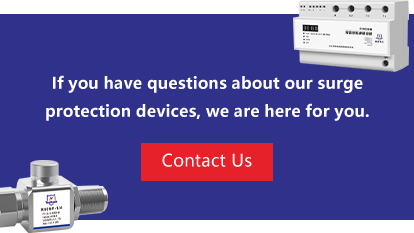Surge Protective Device (SPD) is a device used to protect electronic equipment from power surges or transient voltages. They are connected in parallel with the load power circuit that needs protection and can also be used in power supply networks at all levels. This article will delve into the working principle of surge protective devices and their important role in electrical systems.
Surge protective devices control transient voltages by diverting or limiting surge currents, protecting sensitive electronic equipment connected to them, such as computers, televisions, washing machines, and safety circuits (such as fire detection systems and emergency lighting). These devices contain sensitive electronic circuits that are prone to damage from transient overvoltages; thus, surge protective devices play a crucial role in protecting electrical installation systems.
The primary function of the surge protective device (SPD) is to protect electrical systems and equipment from surge events by limiting transient voltages and diverting surge currents. Surges can come from external sources, the most intense usually being lightning; they can also come from internal electrical load switching. These internal surges (accounting for 65% of all transients) include sources such as load turning on and off, relay and circuit breaker operations, heating systems, motors, and office equipment.
Without proper SPD, transient events can damage electronic equipment and lead to costly downtime. Therefore, the importance of surge protective devices in protecting electrical equipment cannot be overstated.
In the most basic sense, when a transient voltage appears on the protected circuit, SPD will limit the transient voltage and divert the current back to its source or ground. To achieve this, the SPD must contain at least one nonlinear component that switches between high impedance and low impedance states under different conditions.
Under normal operating voltages, the SPD is in a high impedance state and does not affect the system. When a transient voltage appears on the circuit, the SPD switches to a conduction state (low impedance), diverting the surge current back to its source or ground, thus limiting or clamping the voltage to a safer level. After the transient transfers, the SPD automatically resets back to its high impedance state.
Working Principle of SPD
Surge protective devices contain at least one nonlinear component (such as a varistor or spark gap) whose resistance varies with the applied voltage. Their function is to divert discharge or pulse currents and limit overvoltages to downstream devices.
In the absence of a surge, the surge protection device has no effect on the system it is installed in. It acts as an open circuit, maintaining isolation between live conductors and ground.
When a voltage surge occurs, the surge protection device will reduce its impedance in nanoseconds and divert the surge current. At this point, the SPD behaves like a closed circuit, short-circuiting the overvoltage and limiting it to values acceptable to the electrically connected downstream equipment.
Once the pulse surge ceases, the surge protection device will restore its original impedance and return to the open circuit state, continuing to monitor the voltage conditions in the electrical system.
 Principle and Function of Signal Surge Protective DeviceMarch 18, 2025Working Principle of Signal Surge Protective DevicesSignal surge protective devices form a protective barrier by connecting in series between the signal channels and the equipment. When a surge voltag...view
Principle and Function of Signal Surge Protective DeviceMarch 18, 2025Working Principle of Signal Surge Protective DevicesSignal surge protective devices form a protective barrier by connecting in series between the signal channels and the equipment. When a surge voltag...view Selection of Power SPD Surge Protection DeviceFebruary 1, 20231. Discharge current of power surge protection deviceThe discharge current is the most important parameter for selecting a surge protector, which symbolizes the ability of the surge protector to disch...view
Selection of Power SPD Surge Protection DeviceFebruary 1, 20231. Discharge current of power surge protection deviceThe discharge current is the most important parameter for selecting a surge protector, which symbolizes the ability of the surge protector to disch...view Features of A Good Surge Protection DeviceAugust 30, 2021Ⅰ. Features of a good surge protectorAs the name shows, the surge protector can prevent a sudden increase in voltage loss equipment. A low-end type of surge protector is definitely not a power strip ...view
Features of A Good Surge Protection DeviceAugust 30, 2021Ⅰ. Features of a good surge protectorAs the name shows, the surge protector can prevent a sudden increase in voltage loss equipment. A low-end type of surge protector is definitely not a power strip ...view Choosing the Right Power Surge Monitoring Device for Your HomeSeptember 11, 2023In an era where our homes are filled with a multitude of electronic devices, ensuring their safety and longevity is paramount. Power surges, often caused by electrical fluctuations or lightning strike...view
Choosing the Right Power Surge Monitoring Device for Your HomeSeptember 11, 2023In an era where our homes are filled with a multitude of electronic devices, ensuring their safety and longevity is paramount. Power surges, often caused by electrical fluctuations or lightning strike...view Price and Brand of Lightning ArresterJanuary 10, 2022A surge protector, also called as surge diverter, surge suppressor, or surge protection device (SPD), is an appliance designed to protect electrical devices from induced lightning.1. How about the sur...view
Price and Brand of Lightning ArresterJanuary 10, 2022A surge protector, also called as surge diverter, surge suppressor, or surge protection device (SPD), is an appliance designed to protect electrical devices from induced lightning.1. How about the sur...view Surge Protector: Guardian of Thunderstorm WeatherMarch 13, 2023During the high-frequency thunderstorm season, the unstable weather brings not only inconvenience to people's travel but also poses potential safety hazards. Lightning waves can be introduced with...view
Surge Protector: Guardian of Thunderstorm WeatherMarch 13, 2023During the high-frequency thunderstorm season, the unstable weather brings not only inconvenience to people's travel but also poses potential safety hazards. Lightning waves can be introduced with...view